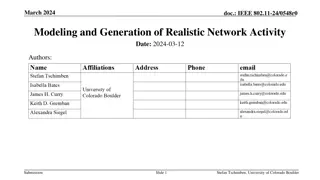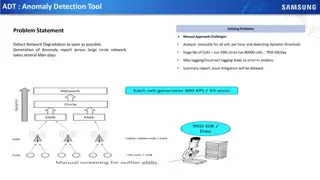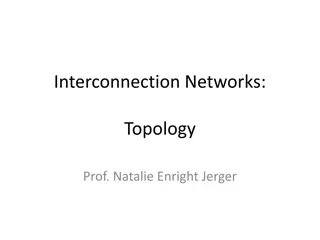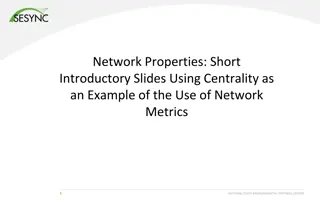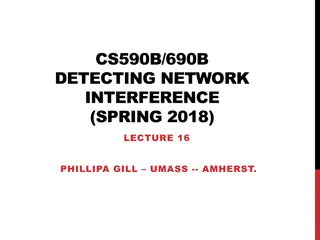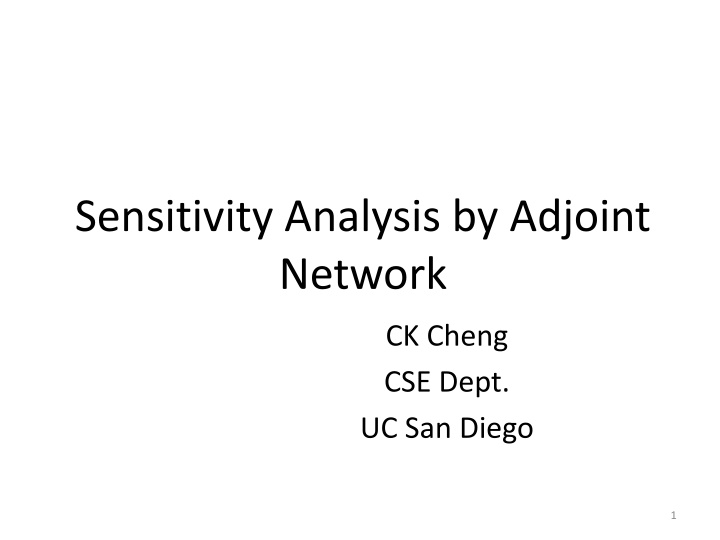
Computer Aided Circuit Simulation and Verification Sensitivity Analysis
Explore the principles of sensitivity analysis in computer-aided circuit simulation, focusing on Tellegen's Theorem and resistive network dynamics. Understand how adjoint networks simplify sensitivity calculations for efficient verification. Dive into examples illustrating the application of Tellegen's Theorem for different circuits.
Download Presentation

Please find below an Image/Link to download the presentation.
The content on the website is provided AS IS for your information and personal use only. It may not be sold, licensed, or shared on other websites without obtaining consent from the author. If you encounter any issues during the download, it is possible that the publisher has removed the file from their server.
You are allowed to download the files provided on this website for personal or commercial use, subject to the condition that they are used lawfully. All files are the property of their respective owners.
The content on the website is provided AS IS for your information and personal use only. It may not be sold, licensed, or shared on other websites without obtaining consent from the author.
E N D
Presentation Transcript
CSE 245: Computer Aided Circuit Simulation and Verification Sensitivity Analysis by Adjoint Network CK Cheng CSE Dept. UC San Diego 1
Outline Introduction Tellegen s Theorem Resistive Network Dynamic System 2
Introduction Sensitivity Calculation Direct calculation: One simulation for each perturbation (Can work for multiple obj. functions). Adjoint network: One simulation for many possible perturbations (Work for one obj. function). 3
Tellegens Theorem Tellegen s Theorem: For a vector of branch voltages and branch currents, we have = = = = T T T T 0 V I V I V I V I b b b b b b b b Note that the branch voltages ??, ?? and branch currents ??, ?? obey the KVL and KCL. 4
Tellegens Theorem V I = T 0 I. b b = T E V V n b v v v v v v 1 1 0 0 0 0 1 0 0 0 0 0 12 = 0 1 0 0 0 1 v v v v 13 1 1 3 0 1 1 0 20 2 4 30 3 1 34 4 1 2 40 5
Tellegens Theorem (cont) V I = T 0 I. b b E I = 0 12 i b 1 3 1 1 0 0 0 0 0 13 i 0 1 0 1 0 0 0 0 20 i 4 = 0 1 0 1 1 0 0 30 i 0 0 0 1 1 0 34 i 2 40 i T = = = T T T 0 V I E V I V EI b b n b n b 6
Tellegens Theorem (cont) V I = T 0 II. b b Example: Two circuits with the same topology 1 (2v) 1 (0v) 3 (3v) 3 (-1v) 1 -2 0 -1 4 (1v) 4 (3v) -1 2 1 -1 0 -1 -1 2 2 (4v) 2 (2v) 7
Tellegens Theorem (cont) V I = T 0 II. b b Example case: Two circuits with the same topology 2 1 4 3 2 1 v 0 40 i ~ 12 i 1 v v v v v v v v v v v 1 2 2 12 i 12 12 ~ 13 i 1 2 2 13 i 13 13 ~ 20 i 1 1 2 20 i 20 20 = = = = ~ 30 i 1 4 1 30 i 30 30 ~ 34 i 0 1 34 i 34 34 ~ 3 1 40 i 40 40 = = = = T T T T 0 V I V I V I V I b b b b b b b b 8
Outline Tellegen s Theorem Resistive Network Dynamic System 9
Resistive Network Objective Function = + y k k f v g i k k k A k B Set A: branch voltages (? = 0) Set B: branch currents (? = 0) Sensitivity Calculation ib y k D R R k Set D: resistances Vb 10
Example of Sensitivity Calculation Given a circuit i2 ?1 R i3 R +_ R =R+ R The objective function (e.g.) ? = ?1 + 2?2 + 4?3 11
Adjoint Network for Resistive Network = + y k k f v g i k k k A k B original network adjoint network -fk _ + Vk R+ R R gk ik +_ = + + T T ( ) ( ) ( ) V I V I v i v i v i v i v i v i b b b b k k k k k k k k k k k k k A k B k D 12
Adjoint Network for Resistive Network (con t) For set A (branch voltage), original network adjoint network -fk _ + vk i = where 0 v ??= ?? where ?? ?? ??????? k k ( ) = = 0 f v v i v i v f k k k k k k k k 13
Adjoint Network for Resistive Network (con t) For set B (branch current), original network adjoint network gk ik +_ = where v 0 i = where is unknown k i v g k k k k = = 0 v i v i g i g i i k k k k k k k k k 14
Adjoint Network for Resistive Network (con t) For set D (resistance), original network adjoint network R+ R R ( ) = = + R v i v R R i k k k k k k k ?? ?? ?? ??= ?????? ????+ ?? ??= ?? ?? ?? 15
Put it together = + + = T T ( ) ( ) ( ) 0 V I V I v i v i v i v i v i v i b b b b k k k k k k k k k k k k k A k k B k D ~ k k + = f V g i i R i k k k k k k k A B D y y R 1 y where ?? = ???= ???? R R y M 16
Outline Tellegen s Theorem Resistive Network Dynamic System 17
Dynamic System Objective Function ib(t) T T = + ( ) ( ) f t v t dt ( ) ( ) k g t i t dt y k k k R k A k B 0 0 Set A: branch voltages Set B: branch currents Sensitivity Calculation Vb(t) C R y L k D k C y k E T = ( ) ( ) b t i t ( ) ( v t i T ) 0 v T t dt k b b b 0 Set D: resistances Set E: capacitances (We omit L here which is similar to C) 18
Adjoint Network for Dynamic System original network adjoint network -fk(T- t) _ + vk(t) R+ R R C+ C C ??(0) = 0 L+ L L gk(T- t) ik(t) +_ T T = = ( ) ( ) b t i t ( ) ( v t i T ) ( ) ( ) k t i t ( ) ( v t i T ) 0 v T t dt v T t dt b b b k k k k A B D E , , , 0 0 19
Adjoint Network for Dynamic System (con t) For set A (branch voltage), original network adjoint network -fk(T- t) _ + vk(t) i t = where ( ) v (t) 0 ??? ? = ??? ? ??? ??(?) ?? ??????? k k T T ( ) t v t dt = ( ) ( ) k t i t ( ) ( v t i T ) ( ) v T t dt f k k k k k 0 0 20
Adjoint Network for Dynamic System (con t) For set B (branch current), original network adjoint network gk(T- t) ik(t) +_ ( ) t where v ( ) t = ( ) ( ) t where ( ) t is unknown = 0 i v T t g i k k k k k T T ( ) t i t dt = ( ) ( ) k t i t ( ) ( v t i T ) ( ) v T t dt g k k k k k 0 0 21
Adjoint Network for Dynamic System (con t) For set D (resistance), original network adjoint network R+ R R ( ) ( ) t R = ( ) ( v t ) ( ) v t i = + R R i t k k k k k k k T T ( ) = R i T + ( ) ( ) k t i t ( ) ( v t i T ) ( ) ( ) ( ) ( ) v T t dt i T t R i t i t R t dt k k k k k k k k k k 0 0 T ( ) ( ) = R i T i t t dt k k k 0 22
Adjoint Network for Dynamic System (con t) For set E (capacitance), original network adjoint network C+ C C ( ) ( ) t ( ) ( ) ( ) = = + where ( ) v t i dt C dv t where ( ) v t i t dt C C dv t k k k k k k k k k 23
Adjoint Network for Dynamic System (con t) For set E (capacitance), T ( ) ( ) k t i t ( ) ( v t i T ) v T t dt k k k 0 T T = C dv t + ( ) ( ) k t i t ( ) ( ) v T v T t C k k k k k 0 0 T T cancellation = + ( ) ( ) ( ) ( ) v T t C dv t v T t C dv t k k k k k k 0 0 T T T = ( ) ( ) ( ) ( ) ( ) ( ( v t d v T ) ) v T t C dv t v T t C v t t C k k k k k k k k k = 0 t 0 0 ??0 = 0 ?? ??????? ??????? T = (0) ( ) ( ) (0) ( ) ( ( v t d v T ) ) v C v T v T C v t C k k k k k k k k k 0 T T overall v T C = + ( ) ( ) k t i t ( ) ( v t i T ) ( ) (0) (0) v ( ) ( ) v T t dt v T t C v t dt k k k k k k k k k 0 0 24
Put it together T T = = ( ) ( ) b t i t ( ) ( v t i T ) ( ) ( ) k t i t ( ) ( v t i T ) 0 v T t dt v T t dt b b b k k k k A B D E , , , b 0 0 T T = + ( ) ( ) C t v t dt ( ) ( i t i T ) ( ) (0) ( ) y t R dt v T C v v T t k k k k k k k k k k D k E k E 0 0 Initial voltage, ??0 , of capacitor ? remains fixed when parameters ??,?? vary. Thus, this term is not relevant to the sensitivities. D T y = ( ) ( i t i T ) t dt k k k R k 0 T y = ( ) ( ) k t v t dt v T k E k C k 0 25
Conclusion Adjoint network can derive sensitivities of all parameters for one objective function. The integration traces backward on the time domain for the dynamic adjoint network. The derivation uses Tellegen s theorm which depends upon the circuit topology only. 26


